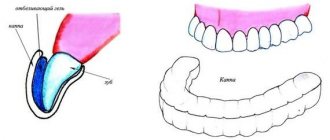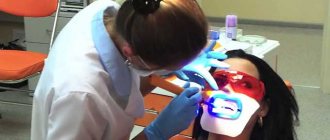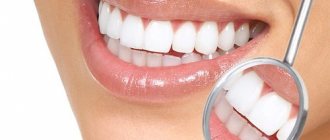Why do teeth darken after whitening?
The following factors influence the change in color and tone of tooth enamel after the procedure:
- external staining (in fact, it is a colored plaque on the teeth);
- penetration of coloring substances deep into the enamel through existing microspaces;
- smoking;
- taking certain medications (for example, iron supplements) or rinsing the mouth with coloring solutions (for example, hydrogen peroxide);
- poor oral hygiene [1].
What is the essence of the white diet?
It is called white not because it consists entirely of dairy products. All products that contain coloring substances that can change the color of tooth enamel are excluded from the menu. You will also have to exclude foods that are too hot and cold, because fragile, peeled enamel does not tolerate temperature changes well. How long can the white diet last after bleaching , and what are the food restrictions? Experts recommend differently, but the minimum is from 24 hours to three days. You can do it longer, then the effect will be better, you can follow it for up to a month.
There are recommendations that you need to follow a white diet after cleansing strictly for 3 days, and then gradually begin to relax and introduce certain foods. For example, you can drink coffee through a straw and then brush your teeth immediately so that it does not affect the enamel. Let’s take a closer look at the foods that need to be excluded and those that can be used in your diet, but it’s up to you to decide how to follow the diet.
Actions to maintain whitening results
After visiting the dentist's office, the work on the beauty of your smile does not end. The recommendations of the attending physician, as well as general standards of oral hygiene, should be followed.
- Brush your teeth daily with a suitable toothbrush.
- Use toothpaste without coloring ingredients.
- Choose a toothpaste that will strengthen the enamel layer and reduce sensitivity (such products contain fluoride compounds - aminofluoride, sodium fluoride or hydroxyapatite).
- Follow a “white” diet.
- Use floss to clean interdental spaces.
- Avoid decorative cosmetics for several days to avoid staining your teeth pinkish-red (lipstick, lip gloss).
The effect of teeth whitening lasts on average six months.
Everyone has a unique dentin color and enamel thickness, so the results will vary. A patient cannot be guaranteed a certain tooth color. It is important to remember that the result does not depend on the drug or the doctor, but rather on the individual characteristics of the body. Akhutina K.K., chief physician of the Allegro dental clinic (two years in a row included in the list of the 100 best private dental clinics in Russia and in the top ten best clinics in St. Petersburg according to the Kommersant Publishing House) [2]
Features such as the natural yellow or grayish tint of the enamel can be changed slightly. In this same situation, careful oral hygiene and good habits can play a decisive role and prolong the whitening effect.
Prevention
If you prepare for the intervention in advance, then you won’t need to think about how to relieve pain after bleaching - it simply won’t be there or it will go away quickly.
What do you need:
- Get professional teeth cleaning. Clean itself has a brightening effect. Not much, but enough to choose the future shade, focusing on the real color of the enamel, without deposits. Tartar is removed so that it does not interfere with the reagents. Otherwise, the tooth near the gum will be darker.
- Cure all carious teeth. Caries is dangerous in principle, and before any intervention the risk of infection increases greatly.
- Undergo dental remineralization (remotherapy). Teeth are saturated with essential minerals, strengthening the enamel. The procedure is recommended, but not mandatory.
- Brush your teeth with a toothpaste for sensitive teeth for at least 2 weeks
before visiting a doctor. - Ask your doctor to numb the pain with gel or paste.
Only temporary fillings are placed before the procedure.
They are changed to permanent ones after bleaching in order to choose the shade. The most effective method of prevention is to choose a safe method
.
Dentist about safe whitening methods
Today, dentists use several methods of gentle teeth whitening:
- Laser whitening. A gentle method that removes stubborn stains. The laser beam allows you to use a gel with a lower concentration, but does not reduce its effect.
- Zoom 4. A reduced concentration of hydrogen peroxide and the use of cold light make this method one of the most gentle.
Home whitening, on the one hand, is considered safer because the concentration of acids is lower. On the other hand, it requires a responsible approach and strict adherence to instructions. Violation of the instructions leads to the fact that teeth ache and hurt after whitening.
Chemical methods are also safe if they are used by doctors with extensive practice in modern clinics where they use the latest methods. One of them is the development of American dentists - Opalescence.
Products hazardous to tooth color
Some products have the ability to color surfaces upon contact, especially porous tooth enamel, due to the presence of their own pigments:
- Black tea;
- cocoa;
- coffee;
- bright sauces (soy, curry, ketchup, etc.);
- colored fruits, including citrus fruits;
- vegetable and fruit juices;
- fruit drinks and compotes;
- carbonated drinks with dyes;
- chocolate;
- berries and jam;
- egg yolks;
- alcohol (red wine).
In the first two weeks, it is especially important to adhere to strict restrictions and recommendations of the dentist. After bleaching, the micropores open and absorb dyes faster. You need to exclude colored foods from your diet at least for the first time.
Is it safe to whiten teeth?
When choosing competent specialists, carrying out the procedure in a dental clinic, using high-quality whitening systems, taking into account all the patient’s health characteristics, whitening is a safe procedure. In the future, doctors monitor patients during regular preventive examinations.
When properly selected, the whitening composition does not harm the enamel and does not affect the strength of hard dental tissues. Our center’s specialists monitor patients who have had their teeth whitened for at least 5 years. To summarize the observations, we can say that clients tolerate this procedure well and are satisfied with its results.
What is necessary for a positive prognosis after whitening? Individual selection of a modern and safe whitening system, regular preventive examinations after teeth whitening and monitoring of the condition of the oral cavity and the whole body.
Thanks to regular meetings with the patient, it is possible to diagnose this or that pathology in a timely manner, assess the condition of dental tissues, the amount of soft and hard deposits on the enamel, and assess the safety of installed fillings and crowns. This allows you to prevent the development of severe conditions that are dangerous to the patient’s health. Our doctors evaluate the quality and extend the service life of fillings and crowns installed by their colleagues from other clinics.
In some cases, you just need to polish the slightly modified filling, and it will be able to stay in the tooth for another couple of years. If minor defects are not corrected, caries may develop in the filled tooth, and the filling will need to be reinstalled in the future. Also, during preventive examinations, hygienists tell patients how best to care for their teeth in order to avoid the appearance of soft plaque and tartar, which toothpaste and brush is best to use, etc.
Teeth whitening
– a serious procedure, therefore, in the presence of severe concomitant diseases, doctors advise against performing it. Most researchers agree that in the short term, whitening does not cause serious harm to health and does not have any significant negative effect on the condition of teeth and gums. More long-term consequences of exposure to atomic oxygen and peroxide compounds included in bleaching systems require more detailed study. Therefore, a person should make a decision about the need to lighten their teeth carefully and thoughtfully after consulting a doctor and reviewing all available information.
What can you eat after teeth whitening?
The post-bleaching diet includes foods high in fluoride, calcium and phosphorus, vitamins C, A and E, and those that do not have bright colors [3, 4]:
- white meat;
- white fish;
- eggs (whites only);
- cereals (rice, pearl barley, oatmeal);
- white beans;
- soft and mild cheese;
- milk (fermented milk products are allowed only after 2-3 days, including yogurt without dyes);
- butter;
- vegetable oil;
- mushrooms with light flesh (white, champignons);
- potato;
- light vegetables (peeled cucumbers, white bell peppers);
- pasta;
- boiled or steamed cabbage;
- white or clear drinks.
Food should be warm or cool - nothing icy or scalding.
Nutrition rules after bleaching
Professional teeth whitening requires strict restrictions in the first days after the procedure. For 2–3 days you should avoid drinks and foods with coloring pigments. You can only eat food that is not brightly colored, not too sweet or sour. The following are prohibited:
- coffee Tea;
- chocolate;
- citruses;
- carbonated drinks;
- all bright vegetables and fruits, including beets, carrots, tomatoes;
- spices and herbs with a coloring effect;
- red wine;
- fermented milk products;
- sauces (mustard, ketchup, etc.).
You can return to a full diet in about a month with a gradual return of coloring foods. Caution should be exercised when eating solid foods, which can damage the enamel. It is advisable not to eat hot and then immediately cold foods, as sudden temperature fluctuations can harm your teeth.
Sample menu for the week
Smile-safe food plan for the first weeks after whitening [3]:
| Days | Breakfast | Snack | Dinner | Dinner |
| 1st and 4th | Oatmeal with milk, cottage cheese, raisins, fermented baked milk. | Yogurt, banana. | Two boiled eggs, green tea with milk, cottage cheese with sour cream. | Cookies, yogurt. |
| 2nd and 5th | Rice porridge with honey, yogurt. | Sandwiches with butter and cheese, yogurt. | Mushroom cheese soup, steamed white meat with vegetables. | Banana, yogurt. |
| 3rd and 6th | Vermicelli porridge with milk, cottage cheese. | A handful of nuts, two boiled eggs. | Noodle soup, boiled potatoes with chicken. | Ryazhenka. |
| 7th | Semolina porridge with milk and butter. | White grapes, peach, peeled apples. | Boiled or baked fish with a side dish of steamed cauliflower. | Salad of peeled cucumbers or light, non-acidic fruits. |
List of sources:
- Burak J. Why teeth darken and how to restore their whiteness, portal “Healthy People” (24health.by), 2022 // URL: https://health.tut.by/news/disease/692875.html (access date: 02.11.2020).
- 10 facts about teeth whitening. Doctor's opinion. ONDOC, 2022 // URL: https://ondoc.me/blog/posts/9 (access date: 12/01/2020).
- Bolotina T.A. White diet after teeth whitening. Blog of practicing dentists DentConsult, 2022 // URL: https://dentconsult.ru/otbelivanie-i-chistka/belaya-dieta-posle-otbelivaniya-zubov.html (date of access: 02.11.2020).
- Vovilyuk A.L. Diet after teeth whitening. Dental portal “Anatomy of teeth”, 2005 // URL: https://yandex.ru/turbo/anzub.ru/s/esteticheskaya-stomatologiya/dieta-posle-otbelivaniya-zubov/ (date of access: 02.11.2020) .
What prohibitions exist after the whitening procedure?
During the white diet, all bright foods and drinks are prohibited. Among them:
- coffee, cocoa, black tea, red wine, juices, fruit drinks;
- carbonated drinks, lemonade, champagne, red wine;
- chocolate, preserves, jams, brightly colored sweets;
- black bread, sweet pastries;
- spices, mayonnaise, ketchup, products containing vinegar, adjika, mustard, colored spices;
- tomatoes, carrots, beets, hot peppers;
- cherries, currants, mulberries, citrus fruits, blackberries, prunes, blueberries;
- green onions, dill, parsley, basil, lettuce.
During this period, you should not eat foods that injure the enamel. These include all spicy, salty, sour, and too hard foods. Hot and cold foods are also prohibited, since temperature changes during this period are undesirable.
To better preserve the enamel, doctors recommend following a gentle diet a week before the procedure. Then, during the procedure, the enamel will suffer less, and the recovery period will be shorter.
Conclusion
Following the simple rules of a white diet will help you prevent the appearance of dark colors on newly bleached enamel. In order not to undergo the teeth whitening procedure frequently, and to maintain its results for as long as possible, you need to exclude prohibited foods, if possible, all the time. If you couldn’t resist eating or drinking something from the prohibited menu, you can immediately brush your teeth; of course, your toothbrush should be available at this time. Chewing gum will not help much in this case. A snow-white smile will be your reward for constantly using restrictions. Teeth whitening and dental care products can be purchased here.










